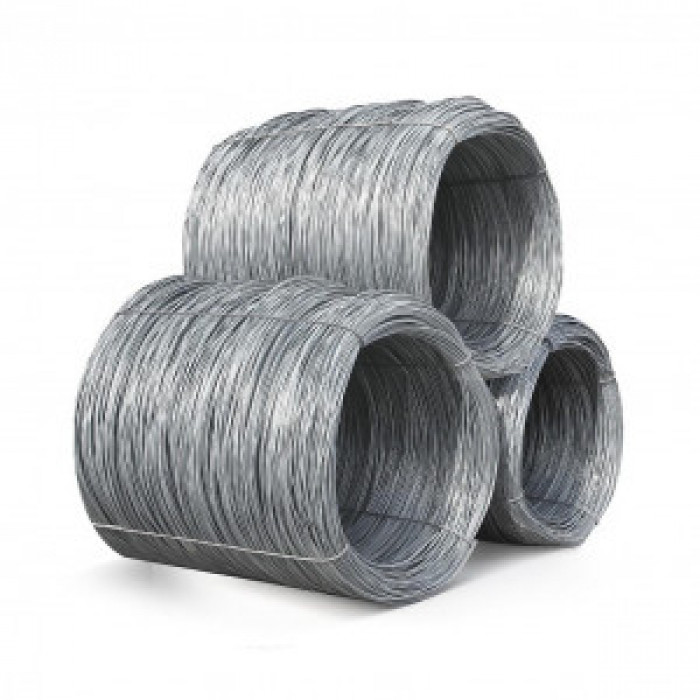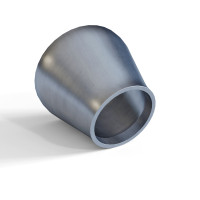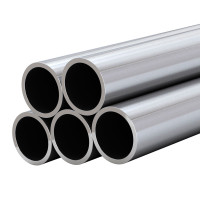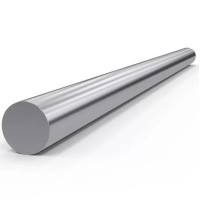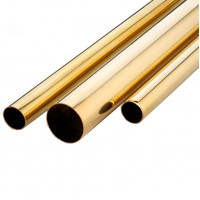Ishmael galvanized wire rod, galvanized strip for grounding, tape, galvanized wire, bar, sheet, profile pipe (Metal rolling), cutting and delivery
Wire rod - a form of viscous material (mainly metal) in the form of a rod 5-10 mm in diameter, produced by hot rolling on a special wire mill. It is a blank for the subsequent production of wire and fittings for reinforced concrete structures.
Wire rod is made by rolling through shafts, hence the name of this rolled metal product. The shafts form and compress the metal from different sides, thus, a wire emerges from a piece of metal (“bloom”). At the end of the rolling mill, it is wound on a special coil, with the help of which the wire rod is placed in rings for further cooling. The method of formation is called hot, in which the metal is not preheated, but is heated when passing through the shafts. After rolling, the wire rod is cooled, the process can go in two ways - air or accelerated cooling. Air cooling occurs naturally, and accelerated in special cooling fans. After cooling, the wire rod is placed in coils and sent to the warehouse. A wire rod with a large diameter (10-15 mm) can also be produced in rods of various lengths.
General requirements
The wire rod shall withstand, when cold, a 180° bend around a mandrel with a diameter equal to that of the wire rod being tested.
Wire rod is made in coils consisting of one continuous piece.
Coils of wire rod in coils must be stacked without mixing. It is allowed to manufacture wire rod in coils consisting of two segments, in an amount not exceeding 10% of the batch weight.
The mass of one skein must be at least 160 kg. It is allowed to have up to 10% of skeins weighing less than 160 kg, but not less than 100 kg in a batch.
A coil mass of at least 50 kg is allowed for wire rod produced on linear mills.
At the request of the consumer, wire rod is supplied with a guarantee of weldability. Weldability is ensured by the chemical composition and manufacturing technology of wire rod.
At the request of the consumer, the size of the ferrite grain is determined in the wire rod. The standards are established by agreement between the manufacturer and the consumer.
Coils consisting of two segments must have two labels.
Each batch is accompanied by a quality document with an additional indication of the wire rod cooling method
Usage
Wire rod can act as a reinforcing structure in the production of reinforced concrete products. In addition, wire rod is used in the production of wires, ropes, ropes and the like. The concept of "rolled wire" can be applied to aluminum and copper rolled products. Aluminum and copper rods are mainly used for the production of wire for power supply systems.
Standardization
The production of wire rod is carried out in accordance with a number of requirements: GOST 30136-95, DSTU 3683-98, TU 14-15-345-94, TU 14-15-346-94, DSTU 2959-94 (GOST 30267-95), specifications for carbon steel wire rod of ordinary quality are regulated by DSTU 2770-94, GOST 30136-95.
Where can you find wire rod?
Where can you find wire rod? This is a hot-rolled wire, which has a round section type, it is mainly used in construction for reinforcing reinforced concrete. Such a process of metal rolling is reflected in artistic forging. If the structure is subjected to various effects of mechanics, then specialists are able to obtain more openwork, delicate, and attractive products that in the future can be used to decorate their gates, facades on buildings, and also used in a modern interior as a special decor.
But in such areas, the use of such a product is far from over. Wire rod will be a good guarantee for the harvesting process during the production of special welding cables, electrodes, ropes, as well as telegraph wires. From it, you can create a thinner type of puncture, which will soon be qualitatively used in the process of supplying electricity, as well as in construction.
The scope of such a product will mainly depend on the material from which it was made. Such material can be soft-type metals such as copper, aluminum, as well as fairly strong steel. Rolled copper is widely used in the telecommunications, automotive and electrical industries with the help of a high-quality electrical conductivity process.
Also, its main advantages include a high fracture strength. From the steel type of blanks, you can create special nails, bolts, nets, screws and other elements for fastening. Aluminum type wire rod will be a good raw material during the implementation of the creation of welding electrodes. It can also be used for steel deoxidation processes. But in any case, wire rod must differ from other types of wire in its increased flexibility, but at the same time it can very quicklydamaged by mechanical forces.
What is the basis for the classification process?
By what principle can the process of classifying wire rod be carried out? But at this point we must pay more attention to the type of rental.
In most cases, this type of wiring is used in the manufacture of domestic products, for example, the same rope must be quite strong and withstand heavy loads, it is for this reason that higher requirements should be placed on its quality.
With all this, wire rod reinforcement can immediately have a number of defects that are unacceptable for production and production of material from which the cable will be created in the future.
In most cases, wire rod is produced both with increased and normal strength. Also, the method of cooling the device can have a significant impact on the features of its characteristics and performance. If the device was subjected to a natural cooling process in air, then this will mean that it is VO, a material that has undergone a process of one or two-stage accelerated cooling, while it is labeled UO1 or UO2 in accordance with the processing method of the device.
In the first case, the alloy of such equipment will contain alloying additives, which can significantly affect its characteristics. Galvanized wire rod has a special layer of protection. Its use in most cases will be reduced to the manufacture of various types of grounding devices.
Steel normalization: description and characteristics
What is steel normalization and a description of this process
Welding wire SV-08G2S: features and varieties
Welding wire sv08g2s: nuances in use, rules for use, types of wire
Classification and marking of steel
Steel marking: principles of classification, metal content depending on the type of alloy
The process of annealing steel and metal: types, features, technology
Description of the annealing process of steel and metal, its types, their features and technology
We all know what wire and a special rod are, but there is also something in between such rolled metal products - this is wire rod. Today it is worth considering in more detail all the characteristics of this product, paying more attention to its production, area of operation and special technical indicators.
Where can you find wire rod?
Where can you find wire rod? This is a hot-rolled wire, which has a round section type, it is mainly used in construction for reinforcing reinforced concrete. Such a process of metal rolling is reflected in artistic forging. If the structure is subjected to various effects of mechanics, then specialists are able to obtain more openwork, delicate, and attractive products that in the future can be used to decorate their gates, facades on buildings, and also used in a modern interior as a special decor.
But in such areas, the use of such a product is far from over. Wire rod will be a good guarantee for the harvesting process during the production of special welding cables, electrodes, ropes, as well as telegraph wires. From it, you can create a thinner type of puncture, which will soon be qualitatively used in the process of supplying electricity, as well as in construction.
The scope of such a product will mainly depend on the material from which it was made. Such material can be soft-type metals such as copper, aluminum, as well as fairly strong steel. Rolled copper is widely used in the telecommunications, automotive and electrical industries with the help of a high-quality electrical conductivity process.
Also, its main advantages include a high fracture strength. From the steel type of blanks, you can create special nails, bolts, nets, screws and other elements for fastening. Aluminum type wire rod will be a good raw material during the implementation of the creation of welding electrodes. It can also be used for steel deoxidation processes. But in any case, wire rod must differ from other types of wire in its increased flexibility, but at the same time it can be damaged very quickly under the influence of mechanical forces.
By what principle can the process of classifying wire rod be carried out. More details of such a device can be found in GOST 30136−94. But at this point we must pay more attention to the type of rental.
In most cases, this type of wiring is used in the manufacture of domestic products, for example, the same rope must be quite strong and withstand heavy loads, it is for this reason that higher requirements should be placed on its quality.
With all this, wire rod reinforcement can immediately have a number of defects that are unacceptable for release.and on the production and manufacture of the material from which the cable will be created in the future.
In most cases, wire rod is produced both with increased and normal strength. Also, the method of cooling the device can have a significant impact on the features of its characteristics and performance. If the device was subjected to a natural cooling process in air, then this will mean that it is VO, a material that has undergone a process of one or two-stage accelerated cooling, while it is labeled UO1 or UO2 in accordance with the processing method of the device.
In the first case, the alloy of such equipment will contain alloying additives, which can significantly affect its characteristics. Galvanized wire rod has a special layer of protection. Its use in most cases will be reduced to the manufacture of various types of grounding devices.
In the marking of the device, you can also find other designations. If a simple wire is made from steel rolled metal, then the marking looks like the symbol P. And at the moment when a special material is produced to create fences, springs in the future, or used in the form of reinforcement, then you should be especially careful to ensure that such rolled was marked with the letter C. If you accidentally saw the symbolism of M, then this will mean only one thing, that the wire rod was made using soft materials.
How is the process of creating wire rod in the shop. Now we must consider in more detail the features of the production of such wire rod. Special metal products that have a special cubic shape, which are called blooms, come to special workshops. After, small types of blanks begin to be created from them. They are cut into smaller pieces. Only after such a process will the main blanks go to the rolling machine, where they will be passed through vertical as well as special horizontal shafts.
Ultimately, the metal will be strongly compressed from all possible sides and acquire the shape it needs. It should be noted that during the drawing of such a product, it will begin to heat up strongly, therefore this production process is called hot. After that, the finished wire of the required diameter will be sent to a specialized winding machine, which will wind it with special rings.
Cooling can be natural or accelerated. In the first case, the product will cool down in air, and in the second case, the finished product can be placed inside a specialized fan hopper.
Steel normalization: description and characteristics
What is steel normalization and a description of this process
Welding wire SV-08G2S: features and varieties
Welding wire sv08g2s: nuances in use, rules for use, types of wire
Classification and marking of steel
Steel marking: principles of classification, metal content depending on the type of alloy
The process of annealing steel and metal: types, features, technology
Description of the annealing process of steel and metal, its types, their features and technology
Where can you find wire rod? This is a hot-rolled wire, which has a round section type, it is mainly used in construction for reinforcing reinforced concrete. Such a process of metal rolling is reflected in artistic forging. If the structure is subjected to various effects of mechanics, then specialists are able to obtain more openwork, delicate, and attractive products that in the future can be used to decorate their gates, facades on buildings, and also used in a modern interior as a special decor.
But in such areas, the use of such a product is far from over. Wire rod will be a good guarantee for the harvesting process during the production of special welding cables, electrodes, ropes, as well as telegraph wires. From it, you can create a thinner type of puncture, which will soon be qualitatively used in the process of supplying electricity, as well as in construction.
The scope of such a product will mainly depend on the material from which it was made. Such material can be soft-type metals such as copper, aluminum, as well as fairly strong steel. Rolled copper is widely used in the telecommunications, automotive and electrical industries with the help of a high-quality electrical conductivity process.
Also, its main advantages include a high fracture strength. From the steel type of blanks, you can create special nails, bolts, nets, screws and other elements for fastening. Aluminum type wire rod will be a good raw material during the implementation of the creation of welding electrodes. It can also be used for steel deoxidation processes. But in any case, wire rod must differ from other types of wire in its increased flexibility, but at the same time it can very quickly damagemove under the influence of mechanical forces.
By what principle can the process of classifying wire rod be carried out? But at this point we must pay more attention to the type of rental.
In most cases, this type of wiring is used in the manufacture of domestic products, for example, the same rope must be quite strong and withstand heavy loads, it is for this reason that higher requirements should be placed on its quality.
With all this, wire rod reinforcement can immediately have a number of defects that are unacceptable for production and production of material from which the cable will be created in the future.
In most cases, wire rod is produced both with increased and normal strength. Also, the method of cooling the device can have a significant impact on the features of its characteristics and performance. If the device was subjected to a natural cooling process in air, then this will mean that it is VO, a material that has undergone a process of one or two-stage accelerated cooling, while it is labeled UO1 or UO2 in accordance with the processing method of the device.
In the first case, the alloy of such equipment will contain alloying additives, which can significantly affect its characteristics. Galvanized wire rod has a special layer of protection. Its use in most cases will be reduced to the manufacture of various types of grounding devices.
In the marking of the device, you can also find other designations. If a simple wire is made from steel rolled metal, then the marking looks like the symbol P. And at the moment when a special material is produced to create fences, springs in the future, or used in the form of reinforcement, then you should be especially careful to ensure that such rolled was marked with the letter C. If you accidentally saw the symbolism of M, then this will mean only one thing, that the wire rod was made using soft materials.
How is the process of creating wire rod in the workshop? Now we have to consider in more detail the features of the production of such wire rod. Special metal products that have a special cubic shape, which are called blooms, come to special workshops. After, small types of blanks begin to be created from them. They are cut into smaller pieces. Only after such a process will the main blanks go to the rolling machine, where they will be passed through vertical as well as special horizontal shafts.
Ultimately, the metal will be strongly compressed from all possible sides and acquire the shape it needs. It should be noted that during the drawing of such a product, it will begin to heat up strongly, therefore this production process is called hot. After that, the finished wire of the required diameter will be sent to a specialized winding machine, which will wind it with special rings.
Cooling can be natural or accelerated. In the first case, the product will cool down in air, and in the second case, the finished product can be placed inside a specialized fan hopper.
In some cases, such wire rod can be subjected to a galvanizing process. Such an additional process will help create the properties we need and need at the surface. The metal, which is pre-coated for protection, is not afraid of exposure and the spread of rust. It has a special brilliance, it does not need to be painted in a different color and so on.
In most cases, simple quality steel of all oxidation states (GOST 380) is used as a material. At this time, the mass number of the carbon fraction inside the STO grade steel should not exceed the parameter of 0.2 percent.
If the total amount of the element is less than 0.12 percent, then the letter M will be in the product marking. But the amount of silicon substance in such a wire can be less than 0.005 percent, but only if the wire rod does not lose all its positive properties and features. Mass for harmful impurities in the product, substances such as phosphorus and sulfur, will not be more than a parameter of 0.04 percent or 0.035 percent, respectively.
The finished product is washed into special bays with a total weight of 160 kilograms. In most cases, they include only one segment. But the formation of whole skeins can also occur, which will consist of two segments, at this time their total mass should not be higher than 10% of the weight of the entire batch.
Such an exception is wire rod, which is created on linear machines, in which case the total mass can reach the mark of 50 kilograms. At the request of the customer, the manufacturer of such a product must guarantee the weldability and quality index of the resulting product. In this case, the marking must be made, following all the rules and instructions of GOST 7566. In the case when the skein consists of several segments at once, then, according toNaturally, there should also be two marking labels.
What can GOST say about the production of wire rod?
Requirements of GOST 2590 for the quality of wire-rod wireProduced wire rod with a diameter that varies from 5 to 9 millimeters, but this figure can be increased according to customer requirements. The dimensions, as well as the maximum deviations in this product, must comply with the rules of GOST 2590. The total ovality in this case should not exceed 50 percent of the sum of the maximum deviations. Quite strict requirements and norms are imposed on the quality of the resulting design, no matter whether this product is created for a machine tool or for the further manufacture of ropes and hardware.
In this case, the presence of special rolling foams, pollution, as well as production dents on the product will be unacceptable. Also among the rejects will be rolled wire with the presence of rolled bubbles, ripples, risks and individual captivity, which adversely affect the overall diameter of the product.
The total mass allowed for such a device will depend on the type of cooling. For single-stage cooling, 18 kg/t will be normal, and for two-stage cooling, 10 kg/t.
If the cooling process of such a product was carried out naturally, then this indicator will not be taken into account. In GOST there are also contributions about the relative narrowing of the cross section, as well as the temporary indicator of resistance.
Wire rod should be subjected to various forms of testing. It must have a high degree of elasticity, and also withstand a 180 degree bend around a simple mandrel, which has a similar diameter. The process of studying the crostructures in the product also takes place, in the presence of common troostomatesite and martensite sections, it is discarded.
In addition, according to the requirements of the customer, it is easy to determine the size of the grain in the ferrite. Permissible norms will be drawn up together with the consumer and the manufacturer of the product. Also, in order to determine the special properties of products, a static control process can be carried out. In more detail, it is worth familiarizing yourself with the requirements that apply to such rolled metal, having studied at the same time GOST 30136–95.
How is this type of piercing delivered to customers?
How wire rod is delivered to customers We have already understood some of the features of the production, characteristics and use of rolled products, here it is worth including the rules for obtaining such products. Wire rod arrives in special bays, while a batch of one product will include products similar in diameter and subjected to the same cooling process. It is also possible to allow the use of special batches, which will include the same rolled products of the same steel grade, but several by type of melts.
At a time when at least one indicator does not meet the required norm, then a second test is carried out according to it, the result of which will apply to the rest of the product batch. If the product manufacturer guarantees compliance with all standards and guidelines, then the wire rod is not subjected to chemical type analysis. For transportation, you can use special wagons, both open and closed. With all this, inside the car it is worth transporting mainly products from the same batch. Such devices should be stored in certain warehouses in coils.
Wire rod properties
Properties of wire rod Wire rod is considered one of the varieties of rolled metal, which occurs with the development of various cross-sectional shapes (semicircular, hexagonal, and also square). In most cases, the process of manufacturing wire rod with a semicircular cross section takes place. Today, wire rod is widely used in both construction and industrial fields.
If we talk about the scope of wire rod, then when it is exposed, useful things are created, such as electrodes, telegraph wires, ropes and wires. In construction work, it is beginning to be used as one of the main reinforcing components that are necessary for the process of erecting reinforced concrete products. The main raw material for the process of creating wire rod will be carbon steel, which must fully comply with the rules of GOST 180.
No questions about this product, be the first and ask your question.

